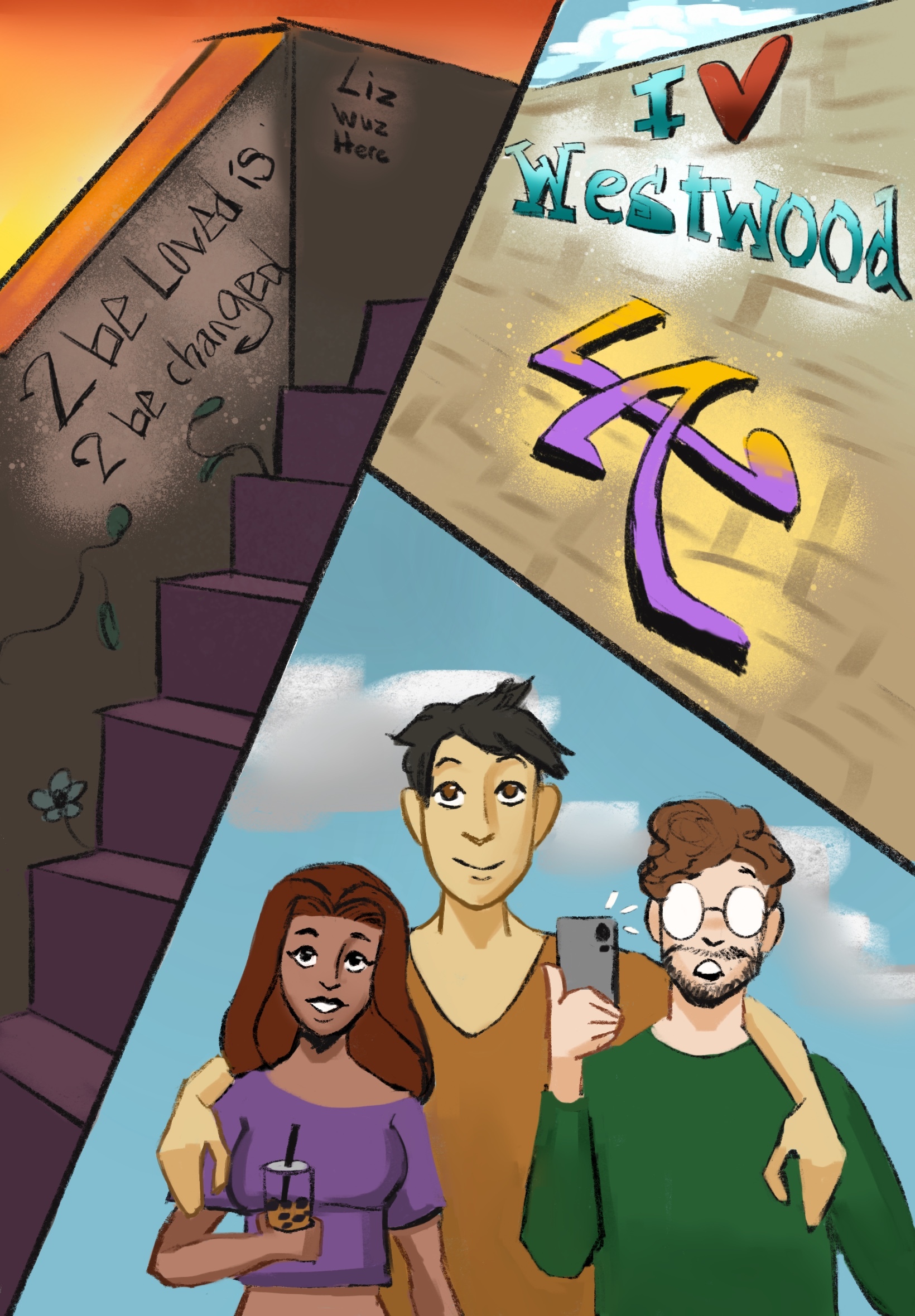Second Take: Powerful messaging of Westwood’s anonymous ‘I’m gay’ tags classifies them as art

(By Elizabeth Elaine Engeda/ Daily Bruin)
By Maya Parra
Dec. 2, 2024 12:55 p.m.
This post was updated Dec. 4 at 7:57 p.m.
Whether they are intended to be art, a series of proclamations or just a practical joke, the “I’m Gay” tags have come to brighten up the Westwood community.
For at least several weeks, an anonymous graffiti artist has been building a scavenger hunt of art across Westwood as new placements of the message “I’m Gay” continue to appear. Their simple work of art consists of just the two words written in all capital letters. The writing has been spotted primarily near the university apartment areas of Westwood but has also been seen on campus, as well as near restaurants along Gayley Avenue, indicating that there is a reasonable chance the artist is a student.
Similar to other instances of graffiti, the purpose and person behind the “I’m Gay” pieces are unknown, and no social media accounts seem to claim the art. It is unclear when or where the first instance of this graffiti appeared, but it is clear that it has become a phenomenon that UCLA students are interacting with on a daily basis. Like most instances of graffiti, whether these pieces can be considered art is up to interpretation. With it being just two words written in a simple design, some may lean toward classifying it as vandalism. However, just as is the case with poetry or lyrics, words can express so much more than their direct meanings.
[Related: Second Take: AI-generated art introduces harmful, unethical narratives to political campaigns]
One possibility is that the two words symbolize a juxtaposition of someone coming out. The artist isn’t exposing audiences to the usually heard “ur gay,” instead laying themselves bare with the phrase “I’m gay” – but doing so in a hidden way. Coming out involves a sense of vulnerability, so the artist might be using their anonymity to make it easier to be vulnerable.
Coming out can also give someone freedom, as they no longer have to hide their sexuality or gender identity, so perhaps the artist wishes to come out and let the world know in the only way they feel they can. Maybe they are telling the entirety of Westwood: “I am here, and I am gay.” It could be that the frequency of the tag hopes to validate members of the LGBTQ+ community and remind them that Westwood is somewhere they can be themselves freely.
Or, it’s possible that the purpose or motivation for this graffiti is none of these things. But if art is subjective, why not see the beauty in its organic presentation? An optimistic view of this footprint left throughout Westwood encourages students to notice their surroundings. With how detached students are from their environment, this art serves to draw attention away from the distractions created by cell phones and toward appreciating one’s surroundings.
In a city like Los Angeles, where modern buildings blend into one another, graffiti serves to distinguish one’s surroundings. With an urban landscape, art additionally serves to brighten up areas and creates something worth appreciating. Such is the case with the large-scale graffiti gallery created earlier this year on abandoned LA high-rises. Few people properly paid attention to the unfinished downtown apartment buildings until they were found covered in graffiti overnight. Now the abandoned buildings are reborn as they have drawn the attention of millions, with some people treating them as a tourist attraction.
[Related: Second Take: Authors risk inauthenticity when portraying marginalized communities not their own]
The same ignorance extends to Westwood dwellers who would not give a second glance to blank walls, stairs or street drains. But with an attention-grabbing set of two words, students can gaze at their surroundings and become excited to have discovered the location of another tag. And with the frequency bias, it will seem like the graffiti is everywhere after seeing it once. Much like Disneyland’s “Hidden Mickeys,” the tag, once given significance, can create joy through being seen.
It is for this reason that these tags can be considered art. Art is not about how grandiose it appears but about the effect it has upon its viewers. Take Maurizio Cattelan’s duct-taped banana piece of art that sold for millions. This extremely simple concept clearly had an effect on its audience, as it gained attention through its ludicrousness. Or take the blank canvas that artist Jens Haaning titled “Take the Money and Run,” which serves to represent poor work wages. The art produced upon it was quite literally nothing, as not even a stroke of paint made its way onto the canvas. If pieces such as these are worthy of being displayed in a gallery, it cannot be denied that Westwood’s latest graffiti can be deemed art.
Because if nothing can be art, everything can be art.


